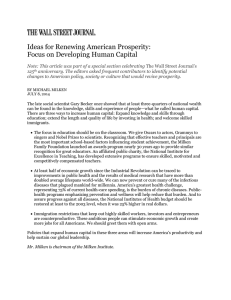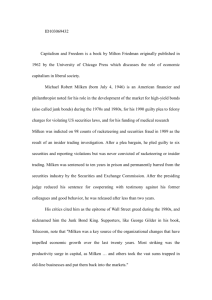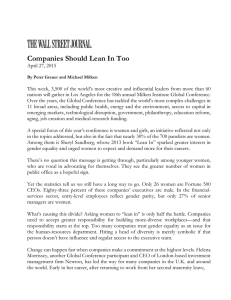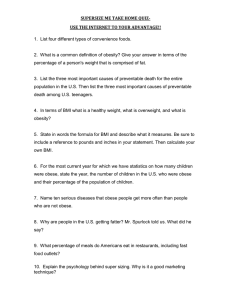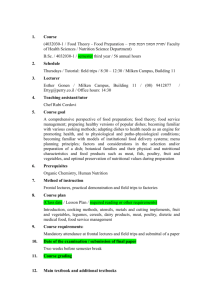The long view of mankind’s civilized life on this planet... the wheel, printing, etc. – that revolutionized human productivity. ...
advertisement
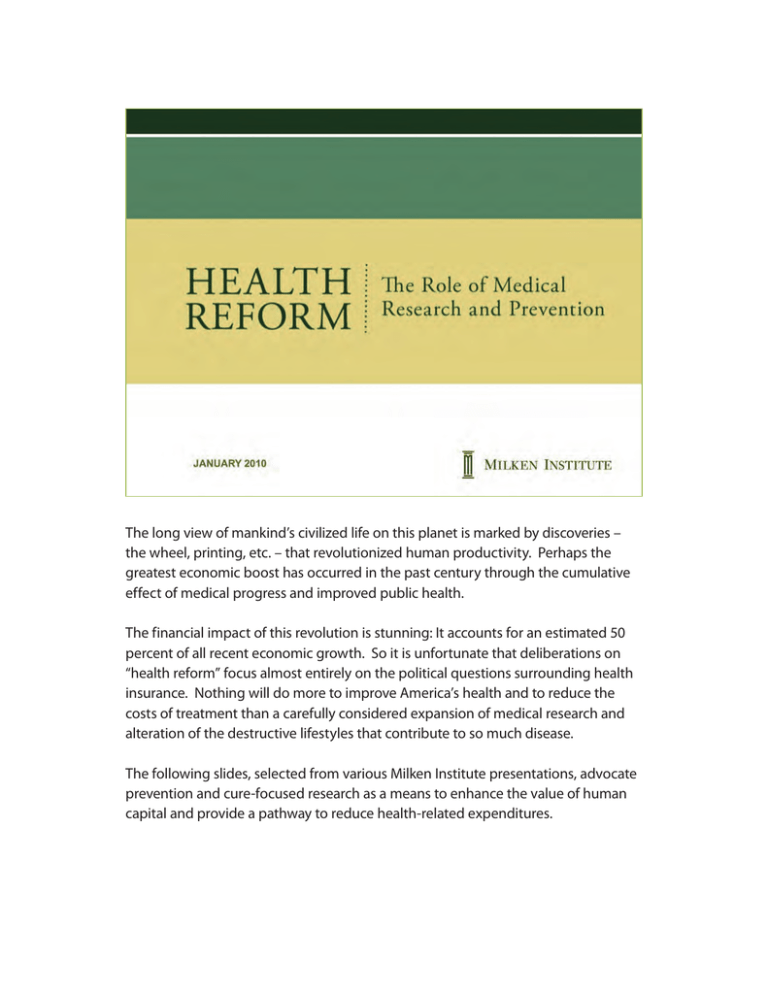
The long view of mankind’s civilized life on this planet is marked by discoveries – the wheel, printing, etc. – that revolutionized human productivity. Perhaps the greatest economic boost has occurred in the past century through the cumulative effect of medical progress and improved public health. The financial impact of this revolution is stunning: It accounts for an estimated 50 percent of all recent economic growth. So it is unfortunate that deliberations on “health reform” focus almost entirely on the political questions surrounding health insurance. Nothing will do more to improve America’s health and to reduce the costs of treatment than a carefully considered expansion of medical research and alteration of the destructive lifestyles that contribute to so much disease. The following slides, selected from various Milken Institute presentations, advocate prevention and cure-focused research as a means to enhance the value of human capital and provide a pathway to reduce health-related expenditures. The three main sections of this presentation show that the best way to reduce healthcare costs is to prevent people from getting sick in the first place and to invest in improved treatments and cures. Medical research and public health programs have extended life spans dramatically and made people more productive. This enhancement of human capital has produced at least 50 percent of all economic growth over the past century. But lifestyle issues primarily related to diet and exercise have produced an obesity epidemic that could threaten this progress. We believe that prevention and curebased research are the most-effective responses to this threat. Prevention and cures will reduce human suffering and costs while stimulating the economy over the long term. The relationship of health to economic progress emerges from studies of “human capital” – the skills, education and experience of people – that indicate healthier people are more productive. Much of the Milken Institute’s academic work centers on human capital as a factor of prosperity. Back in the 1960s, Institute Chairman Michael Milken developed a formula that says prosperity equals the collective value of financial technologies multiplied by the total of human capital, social capital and real assets. [A detailed discussion can be found in several articles at www.mikemilken.com.] Human capital is the most important factor in the prosperity formula. But with one exception (professional sports), human capital is not listed as an asset on corporate or national balance sheets. One way to illustrate the value of human capital is to show the impact of one person. Consider the tale of two baseball teams. Between 1914 and 1919 the Boston Red Sox dominated the sport, winning half the championships in that sixyear period. The backbone of their team was Babe Ruth, who had a .308 batting average and a World Series pitching earned run average of 0.87. During those six years, the New York Yankees failed to win a single World Series. But in the 14 years after Ruth was traded to the Yankees, they won half the championships, while Boston was shut out. On-field success also translated to financial success – between 1918 and 1920 attendance at Yankee games tripled and was essentially flat in Boston. This phenomenon is not limited to sports. The value of many commercial enterprises has soared or plummeted because of one leader’s impact. And it can happen to an entire nation: One person, Lee Kwan Yew, almost single-handedly brought Singapore from economic backwater to global competitor. This is why official balance sheets of companies or nations are usually inaccurate. According to the Federal Reserve, the balance-sheet value of assets held by U.S. households was about $67 trillion in late 2009. But this represents only a small part of America’s wealth. Dr. Gary Becker, often called “the father of human capital studies,” won the Nobel Prize for demonstrating that human capital has a far greater value than financial, household and industrial assets. Traditional balance-sheet items represent only about a quarter of national wealth. Most of the rest is human capital. So anything that increases human capital – by making people more productive over longer working lives – has a large impact. Because human capital is so valuable, it can be leveraged by financial technology to increase employment and accelerate economic growth. Thus, for example, when the U.S. expanded access to capital through financial-market innovations in the 1970s and 1980s, employment soared. Between 1970 and 2000, America created more than 60 million net new jobs – far outpacing the rest of the world, where employers still depended on borrowing from financial institutions (instead of in markets) for growth capital. There are only three ways for any nation to increase the value of human capital – through health, education or immigration. Health improvements that offer citizens not only longer life, but also a better quality of life, make people more productive and better able to sustain long-term GDP growth. Many countries have recognized that attracting bright immigrants in medicine and the sciences is an effective economic strategy. As a result, nations around the world are increasingly competing for the services of innovative people. Amid this competition, the U.S. is increasingly dependent on foreign-born human capital: • One-third of all doctoral students in America come from other nations. • More than half of Silicon Valley’s science and engineering workforce is foreign-born, and 15 percent of its start-up companies were founded by immigrants from India. Another 13 percent had CEOs from China or Taiwan. • These immigrants apply for a growing share of U.S. patents. • Among all U.S. doctors, 150,000 – 20 percent of the total – are foreign-born. Nowhere is this more true than in the life sciences. Singapore has been especially aggressive in recruiting world-class scientists from the U.S., France, Germany, Japan and the U.K. Biomedical investigators from these and other advanced nations have signed on to conduct at least part of their research in Singapore. China has similar ambitions and is spending heavily to attract researchers from around the world. This competition for human capital is the latest chapter in the history of our civilization. Nobel laureate Robert Fogel showed that there was very slow population growth for thousands of years. In the first millennium of the modern era, there was also virtually no economic growth. Between the year 1000 and 1800, economic growth was only one-seventh of one percent per year – hardly noticeable within any individual’s lifetime. But starting in the first half of the 19th century, global population began to grow rapidly along with an explosion of scientific discovery. Improvements in health were among the most-important advances. Health improvements contributed to an extension of life expectancy in the last century that may turn out to be one of the most-significant achievements in the history of the human race. Every advanced nation wants to take the lead in building on the progress of the 20th century. In one century, average life spans on planet Earth – including all the leastdeveloped regions – more than doubled. We sometimes forget that only a little more than 100 years ago, babies died routinely in the United States. In fact, one of every five babies born in 1900 did not live to celebrate a fifth birthday. Power and wealth was no protection – about a third of U.S. Presidents have lost a child in infancy. In 100 years, we made great progress against infectious diseases, largely as a result of public sanitation programs and the development of antibiotics. Medical research has almost entirely eliminated the threat of some dreaded diseases. The resulting reduction in suffering and grief is priceless. But if looked at only in dollars and cents, the return on investment in medical research has produced a major economic boost. Even some forms of cancer have become less deadly. Childhood leukemia and testicular cancer now have very high cure rates, thanks to research investments. Progress against heart disease – still the number-one killer – has saved millions of lives and trillions of dollars. The combined effect of public-health programs – including sanitation, antismoking and safe-driving campaigns – plus better treatments resulting from research have added decades to the life of the average American. Just since 2000, we’ve added another year and a half to average U.S. life spans, which now exceed 78 years. This has changed the way we view people at different ages. But it’s not just body image that’s changed in the past half-century. The actual health profiles of 60-year-old men and women are now similar to those of 40 year olds in 1960. So 60 truly is the new 40! Depending on the models used, economists differ on the exact contribution of health improvement to economic growth over hundreds of years. But considering the impact on reduction of illness, increased productivity and longer working lives, these advances may have been responsible for as much as half of all increases in wealth. Good data are available for recent decades and a careful study by University of Chicago economists Kevin Murphy and Robert Topel shows that the 50-percent estimate is in fact accurate, at least since 1970. Longer lives increased America’s aggregate wealth by an average $3.2 trillion each year between 1970 and 2000. It’s difficult for any individual to relate to aggregate national numbers in the trillions. But at the individual level, Americans have gained, on average, $1,200,000 each because of 20th-century life extension. With a population of about 300 million in 2000, that suggests a total national gain from 20th-century life extension of $360 trillion. Compare that to approximately $50 trillion in worldwide paper losses on financial and real-estate assets at the bottom of the recent recession. Investments that increase human capital even slightly more than offset short-term financial setbacks. This shows the economic value of eliminating four serious diseases as a cause of death and suffering in the United States. But even just a one-percent reduction in cancer or heart-disease deaths would be worth more than half a trillion dollars to current and future Americans. How do we know that eliminating life-threatening diseases like heart disease and cancer would produce such large economic benefits? One way to measure that is to look at what happens when there is even a small advance against disease. In 2005, Genentech announced that the biotechnology drug Avastin had been approved by the Food and Drug Administration for use in treating lung cancer. It was not a cure and had only a small benefit in terms of extending life – a few months. Yet within one hour of the announcement, the value of Genentech stock increased more than $11 billion. One month later, when Avastin was shown to have some benefit in treating breast cancer, the stock soared even more. The best treatment for any disease is to prevent it from occurring in the first place. It’s also one of the best ways to reduce our national healthcare bill. At least 70 percent – some analysts say 75 percent – of all health expenditures are related to illness caused or made worse by the way we live our lives – what we eat, how much we eat, whether we smoke, how sedentary or active we are, etc. Only a minority of disease is genetically determined. We’ve made some progress against smoking. But it took a long time. As far back as 1939, the government first suggested that tobacco could be dangerous. In the 1950s, authority figures such as doctors were often shown promoting tobacco consumption. Cigarette ads featured famous sports stars, glamorous actresses, soldiers and sailors, scientific researchers, cute babies, future Presidents, dentists … even Santa Claus. They often showed their sophistication by posing with smoke rising from their mouths. The message was clear: Just about everyone smoked, especially attractive, smart, successful people. If doctors, dentists and scientists smoked, how bad could it be? And they all seemed so happy to be puffing away. It was hard to not smoke and even harder to stop. Yet as bad as smoking was (and continues to be – it kills hundreds of thousands each year in America and tens of millions worldwide), it has less of an impact than excess weight. According to a Rand Corporation study, “Obese individuals spend more on health care than smokers and heavy drinkers.” And the U.S. is where obesity is most prevalent – a World Health Organization study said it is more than five times as prevalent as in France, a nation famous for its rich food and free-flowing wine, and 20 times the rate of Japan. (The methodology of this study differed from those within the United States, so the data aren’t exactly comparable on the following pages. But no matter what statistical method is employed, no one doubts that excess weight is a very serious problem in America.) Not surprisingly, the Japanese enjoy six more healthy years, on average, than Americans. Overweight and obese people run far higher risks of many diseases. For example, the American Institute for Cancer Research says there is “a convincing connection between excess fat and cancers of the esophagus, pancreas, colon and rectum, endometrium and kidney, along with breast cancer in post-menopausal women.” Repeated studies show that the excess pounds we pack on are killing us prematurely. The Living Heart Foundation has studied the health risks facing professional football players. They found that the game’s biggest players – linemen – are most at risk, with more than a third having enlarged hearts, as many as 75 percent suffering from obstructive sleep apnea and more than half with metabolic syndrome, which puts them at greater risk for heart disease. Another study in the American Journal of Cardiology found that virtually all people weighing more than 300 pounds had enlarged hearts and narrowed coronary arteries. It is frightening to think that after hundreds of thousands of years of evolution, we have suddenly changed the shape of our bodies in less than 20 years. In 1991, only four U.S. states – Louisiana, Mississippi, West Virginia and Michigan – reported that more than 15 percent of their citizens were obese. A decade later, 49 out of 50 states passed 15 percent obesity prevalence. And one year after that, the last holdout – Colorado – joined the crowd. Then it got much worse. By 2009, about half the states had not only passed the 15-percent mark, but they reported between 25 and 30 percent were obese. And four states now surpass 30 percent. Two of the only four states that exceeded 15 percent in 1991 – Mississippi and West Virginia – are now in the 30-percent club. Those 30 percent are not just a little overweight – they’re clinically obese. The problem affects women … … and men. Four million Americans weigh more than 300 pounds, and half a million weigh more than 400 pounds. But perhaps most tragically, children are getting fatter, even at the youngest ages. We can’t say for sure what the future holds for these children since there is no historical precedent for the obesity epidemic. But expert projections are not encouraging. A report in the New England Journal of Medicine said that “pediatric obesity may shorten life expectancy by 2-5 years by mid-century – an effect equal to all cancers combined.” Nearly everyone knows how to avoid obesity. But that knowledge is hard to translate into behavior because we evolved with a well-adapted ability to endure starvation. Our ancestors subsisted on a high-fiber, low-fat diet. The ability to hang onto calories efficiently was a survival factor for ancient humans and helped them survive epidemics of infectious disease and famine. The adaptation to starvation does not prepare people to cope with an epidemic of over-nutrition and under-activity. One of the problems in America is portion sizes. The French, for example, are known to eat more slowly and savor smaller portions. Even supposedly healthy foods pack more calories per portion. And too often we fall victim to bigger-is-better sales pitches. As the relative cost of food ingredients as a percent of our disposable income declines, it becomes easier to justify larger sizes. Within any given portion size, the composition of processed foods can help make us fat. The unfortunate result is not just an epidemic of obesity, but also an epidemic of diabetes. Wartime records show that when people were “deprived” of their favorite sugarladen, fatty foods and became more active, diabetes declined. Rationing also had a positive effect on heart health. Even as we consume more calories, we burn fewer. Schools have cut back on physical education programs to save money or to meet other requirements. We even take it easy on the way to working out! No one should underestimate how hard it is to change behavior, especially when evolution has programmed us to retain fat. But we’ve successfully made changes in other difficult areas. The key may lie in educating the public about the true costs – to our health and our pocketbooks – of obesity. A 2007 Milken Institute research report provided exhaustive data on the economic consequences of chronic diseases and highlighted obesity’s impact. A major conclusion of the report is that the costs of chronic disease can be controlled – they result mostly from lifestyle decisions, not heredity. The preventable costs are already more than $1 trillion, said the report. By midcentury, America’s GDP will be an estimated $6 trillion lower if we fail to contain chronic-disease costs. A unique conclusion of the study was that many of the costs are insidious – they derive from such indirect effects as absenteeism from work and “presenteeism.” Sick employees who go through the motions of their jobs with reduced productivity create an enormous economic drag. In fact, “presenteeism” is the largest single factor in reducing our nation’s economic potential. Only modest changes – such as returning to our average weight in 1998 (which was still too heavy) – would produce a $1.1 trillion benefit over the next decade and a half. The Milken Institute study urges policymakers to provide wellness incentives, especially those that encourage people to achieve healthy body weights. Prevention is one of the two most-effective strategies to reduce costs in our health system. The other important strategy is to make greater investments in medical research focused on cures. Organizations related to the Milken Institute have been addressing the issue of medical research for three decades. In 1982, the Milken Family Foundation began working to bring more innovations to education and medical research. It supported the research of many medical investigators who later earned the highest recognitions in their profession for life-saving breakthroughs. Among those who received awards in the 1980s were Dr. Dennis Slamon, who later discovered Herceptin, a revolutionary breakthrough in the treatment of one type of breast cancer; Dr. Steven Rosenberg, who reported a major breakthrough in the development of successful gene therapy that for the first time in history harnesses the body’s own immune system to shrink tumors; and Dr. Bert Vogelstein, who did pioneering work on the incalculably important p53 gene whose mutant form is believed to be involved in more than half of human cancers. Also receiving MFF support were Dr. Owen Witte, whose subsequent work provided the basis for the development of the breakthrough drug Gleevec, now used as a frontline therapy for patients with chronic myelogenous leukemia; Dr. Lawrence Einhorn, who as the developer of a highly successful chemotherapy regimen for testicular cancer later treated seven-time Tour de France winner Lance Armstrong; Dr. Philip Leder, a pioneer in molecular biology who contributed to the deciphering of the genetic code; Dr. Charles Myers, who went on to become Chief of the Clinical Pharmacology branch of the National Cancer Institute; and many more. The Foundation’s medical programs are not limited to cancer. Over the past quarter century, investigators in a wide range of medical fields have contributed to breakthroughs with support from the MFF. For example, researchers have helped create advanced therapies that reduce the impact of epilepsy and help arrest seizures. Beginning in 1993, the Prostate Cancer Foundation (with initial support from the Milken Family Foundation and now a publicly supported charity) began to break the mold of how medical research could be conducted. The PCF was originally called CaP CURE, a name that reflected three goals – “Ca” stood for all cancers; “P” represented prostate; and “CURE” symbolized the ultimate goal of major progress against all deadly diseases. Later, the organization known as C-Change took on the mission of defeating all cancers; and FasterCures was established to speed progress against a broad range of life-threatening diseases. That allowed CaP CURE to become the Prostate Cancer Foundation and focus its efforts on defeating prostate cancer. These efforts are described in the book “A Call to Action,” available at www.pcf.org, www.amazon.com and other online booksellers. Researchers at “competing” medical institutions were told they’d have to share their findings freely – regardless of publication status – at an annual scientific retreat if they wanted financial support. The grant application process was greatly simplified. Instead of spending months preparing grant proposals – as the National Institutes of Health required – and waiting a year or more for a response, investigators had to submit only five pages. They received an answer in less than 60 days and funding in 90 days. This was unheard of. Most importantly, the PCF rewarded game-changing hypotheses and innovative methods that could transform the field. Acting more like a venture capital firm than a bureaucratic charity, the PCF created a sense of urgency that energized the field and accelerated scientific discovery. The PCF model was eventually adopted by dozens of other disease-specific advocacy groups. The National Institutes of Health later streamlined its application process and recently began a relatively small program of New Innovator Awards for work unlikely to be funded through the existing review process. More importantly, they and the Food and Drug Administration adopted most of the recommendations of a 10-point plan delivered by PCF Chairman Michael Milken at the 1995 National Cancer Summit. Albert Einstein was 26 when he conceived the Special Theory of Relativity. Jonas Salk was 30 when the March of Dimes identified the promise of his ideas and provided funding that led to the elimination of polio. Many Nobel prizes have been awarded for work begun within five years of the laureate’s graduation. Yet scientific researchers don’t receive their first grant from the National Institutes of Health (NIH) until an average age of 43. From its earliest days, the Milken Family Foundation has seen the greatest progress emerge from its grants to young investigators. Unfortunately, the traditional peerreview system discourages young scientists from taking the very kinds of risks on which all advances depend. They quickly learn that the way to get funded is to follow the lead of their predecessors with conservative, low-risk proposals for incremental improvements to “proven” ideas. Science magazine recently noted that only 0.27% of the NIH budget is devoted to programs encouraging true innovation. The Prostate Cancer Foundation is working to encourage breakthroughs by devoting an increasing portion of its resources to Young Investigator Awards designed to stimulate innovation by recent physician/scientist graduates. Despite progress over the years, bureaucratic and regulatory inefficiencies still impede the advance of medical science. In 2003, FasterCures was established as a Washington-based center of the Milken Institute with the goal of saving lives by saving time in the research, discovery and development of new medical solutions. FasterCures does not sponsor research directly. Rather, it works to remove the barriers to progress. The organization’s mission is analogous to a train. We know how to make trains that run 300 miles per hour. Yet in America, average train speed hasn’t increased in a century. The problem isn’t the train; it’s the tracks. We’re limited by the old tracks and the infrastructure that has grown up around them. In the same way, medical science is hampered by 19th- and 20th-century thinking. Few changes would do more to accelerate the process of research advances than greater access to data – the almost limitless statistical goldmine that we all offer during routine tests and clinical trials. Unfortunately, well-meaning but misguided restrictions on the use of data slow down the train of medical progress. FasterCures is working to minimize these restrictions so we can rapidly enter an era of personalized medicine that will allow faster and more-accurate prediction of disease risk – and eventually, new therapies to prevent disease progression. Much of the data are within us. We need better public policies that allow those of us who want to share it to do so — while protecting the legitimate privacy concerns of everyone. Speeding the train of medical science through wider use of data will assure continued extensions of productive years for people everywhere. We also need to dedicate more resources to the process of medical research. At a time when policymakers are debating the impact of government stimulus programs, we should recognize that medical research produces the greatest stimulus of all. The argument in favor of research investment becomes stronger if we compare it to other expenditures. National political campaigns in 2008 cost $5.3 billion. Interestingly, Americans also spend $5.3 billion a year on potato chips. Potato chips! Nearly double the federal budget for heart-disease research. More than the National Cancer Institute budget. Repeated surveys have shown that Americans would be willing to pay more in taxes if it assured medical progress. Today we build roads and bridges to stimulate the economy. But the greatest stimulus over the long term would come from a far larger allocation of resources to medical research. When increased research investments are combined with adoption of healthier lifestyles, we can leave our children and grandchildren a legacy of longer, healthier lives. These health issues are part of a major track at the annual Milken Institute Global Conference. Each year, a wide range of panels deals directly with health, health reform and related issues. Hundreds of distinguished scientists, physicians, government officials, health advocates, financial leaders, journalists and economists – including many Nobel laureates – have debated the best routes to medical solutions at the Global Conference. (See the Health Leaders tab for a more-complete list.) Additional information is available at www.milkeninstitute.org.
